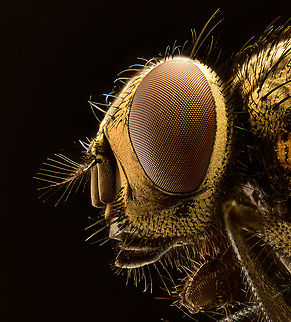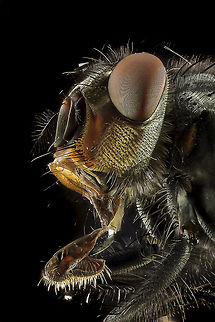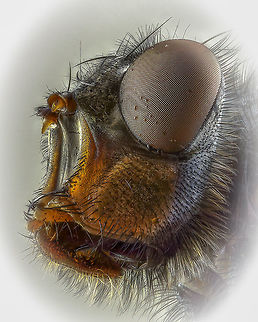
Appearance
Adult houseflies grow to 8–12 millimetres long. The thorax is gray or sometimes even black, with four longitudinal dark lines on the back. The whole body is covered with hair-like projections. The females are slightly larger than the males, and have a much larger space between their red compound eyes.Pupae can range from about 8 to 20 mg under different conditions.
Like other Diptera , houseflies have only one pair of wings; what would be the hind pair is reduced to small halteres that aid in flight stability. Characteristically, the media vein shows a sharp upward bend.
Species that appear similar to the housefly include:
⤷ The lesser house fly, ''Fannia canicularis'', is smaller, more slender, and the media vein is straight.
⤷ The stable fly, ''Stomoxys calcitrans'', has piercing mouthparts and the media vein is only slightly curved.

Behavior
Each female fly can lay approximately 500 eggs in a lifetime, in several batches of about 75 to 150. The eggs are white and are about 1.2 mm in length. Within a day, larvae hatch from the eggs; they live and feed on organic material, such as garbage, carrion or feces. They are pale-whitish, 3–9 mm long, thinner at the mouth end, and have no legs. Their life cycle ranges from 14 to 90 days. At the end of their fourth instar, the maggots crawl to a dry, cool place and transform into pupae, coloured reddish or brown and about 8 mm long. The adult flies then emerge from the pupae. The adults live from two weeks to a month in the wild, or longer in benign laboratory conditions. Having emerged from the pupae, the flies cease to grow; small flies are not necessarily young flies, but are instead the result of getting insufficient food during the larval stage.Some 36 hours after having emerged from the pupa, the female is receptive for mating. The male mounts her from behind to inject sperm. Copulation takes a few seconds to a couple of minutes. Normally, the female mates only once, storing the sperm to use it repeatedly for laying several sets of eggs.
The flies depend on warm temperatures; generally, the warmer the temperature, the faster the flies will develop.

Evolution
Even though the order of flies is much older, true houseflies are believed to have evolved in the beginning of the Cenozoic era. They are thought to have originated in the southern Palearctic region, particularly the Middle East. Because of their close, commensal relationship with humans, they probably owe their worldwide dispersal to co-migration with humans.The house fly is the most common of all domestic flies, accounting for about 91% of all flies in human habitations, and indeed one of the most widely distributed insects, found all over the world.
References:
Some text fragments are auto parsed from Wikipedia.